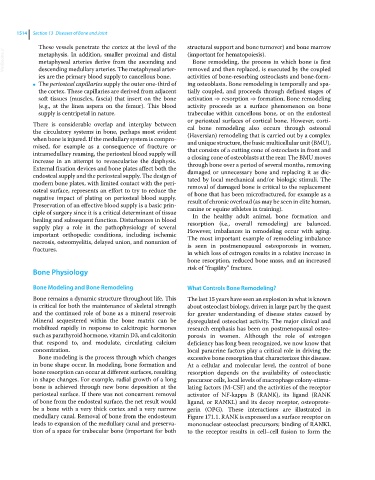Page 1576 - Clinical Small Animal Internal Medicine
P. 1576
1514 Section 13 Diseases of Bone and Joint
These vessels penetrate the cortex at the level of the structural support and bone turnover) and bone marrow
VetBooks.ir metaphysis. In addition, smaller proximal and distal (important for hematopoiesis).
metaphyseal arteries derive from the ascending and
Bone remodeling, the process in which bone is first
descending medullary arteries. The metaphyseal arter-
activities of bone‐resorbing osteoclasts and bone‐form-
ies are the primary blood supply to cancellous bone. removed and then replaced, is executed by the coupled
The periosteal capillaries supply the outer one‐third of ing osteoblasts. Bone remodeling is temporally and spa-
●
the cortex. These capillaries are derived from adjacent tially coupled, and proceeds through defined stages of
soft tissues (muscles, fascia) that insert on the bone activation ⇒ resorption ⇒ formation. Bone remodeling
(e.g., at the linea aspera on the femur). This blood activity proceeds as a surface phenomenon on bone
supply is centripetal in nature. trabeculae within cancellous bone, or on the endosteal
or periosteal surfaces of cortical bone. However, corti-
There is considerable overlap and interplay between cal bone remodeling also occurs through osteonal
the circulatory systems in bone, perhaps most evident (Haversian) remodeling that is carried out by a complex
when bone is injured. If the medullary system is compro- and unique structure, the basic multicellular unit (BMU),
mised, for example as a consequence of fracture or that consists of a cutting cone of osteoclasts in front and
intramedullary reaming, the periosteal blood supply will a closing cone of osteoblasts at the rear. The BMU moves
increase in an attempt to revascularize the diaphysis. through bone over a period of several months, removing
External fixation devices and bone plates affect both the damaged or unnecessary bone and replacing it as dic-
endosteal supply and the periosteal supply. The design of tated by local mechanical and/or biologic stimuli. The
modern bone plates, with limited contact with the peri- removal of damaged bone is critical to the replacement
osteal surface, represents an effort to try to reduce the of bone that has been microfractured, for example as a
negative impact of plating on periosteal blood supply. result of chronic overload (as may be seen in elite human,
Preservation of an effective blood supply is a basic prin- canine or equine athletes in training).
ciple of surgery since it is a critical determinant of tissue In the healthy adult animal, bone formation and
healing and subsequent function. Disturbances in blood resorption (i.e., overall remodeling) are balanced.
supply play a role in the pathophysiology of several However, imbalances in remodeling occur with aging.
important orthopedic conditions, including ischemic The most important example of remodeling imbalance
necrosis, osteomyelitis, delayed union, and nonunion of is seen in postmenopausal osteoporosis in women,
fractures.
in which loss of estrogen results in a relative increase in
bone resorption, reduced bone mass, and an increased
risk of “fragility” fracture.
Bone Physiology
Bone Modeling and Bone Remodeling What Controls Bone Remodeling?
Bone remains a dynamic structure throughout life. This The last 15 years have seen an explosion in what is known
is critical for both the maintenance of skeletal strength about osteoclast biology, driven in large part by the quest
and the continued role of bone as a mineral reservoir. for greater understanding of disease states caused by
Mineral sequestered within the bone matrix can be dysregulated osteoclast activity. The major clinical and
mobilized rapidly in response to calcitropic hormones research emphasis has been on postmenopausal osteo-
such as parathyroid hormone, vitamin D3, and calcitonin porosis in women. Although the role of estrogen
that respond to, and modulate, circulating calcium deficiency has long been recognized, we now know that
concentration. local paracrine factors play a critical role in driving the
Bone modeling is the process through which changes excessive bone resorption that characterizes this disease.
in bone shape occur. In modeling, bone formation and At a cellular and molecular level, the control of bone
bone resorption can occur at different surfaces, resulting resorption depends on the availability of osteoclastic
in shape changes. For example, radial growth of a long precursor cells, local levels of macrophage colony‐stimu-
bone is achieved through new bone deposition at the lating factors (M‐CSF) and the activities of the receptor
periosteal surface. If there was not concurrent removal activator of NF‐kappa B (RANK), its ligand (RANK
of bone from the endosteal surface, the net result would ligand, or RANKL) and its decoy receptor, osteoprote-
be a bone with a very thick cortex and a very narrow gerin (OPG). These interactions are illustrated in
medullary canal. Removal of bone from the endosteum Figure 171.1. RANK is expressed as a surface receptor on
leads to expansion of the medullary canal and preserva- mononuclear osteoclast precursors; binding of RANKL
tion of a space for trabecular bone (important for both to the receptor results in cell–cell fusion to form the

